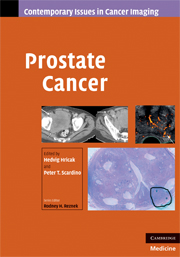Book contents
- Frontmatter
- Contents
- Contributors
- Series Foreword
- Preface
- 1 Anatomy of the prostate gland and surgical pathology of prostate cancer
- 2 The natural and treated history of prostate cancer
- 3 Current clinical issues in prostate cancer that can be addressed by imaging
- 4 Surgical treatment of prostate cancer
- 5 Radiation therapy
- 6 Systemic therapy
- 7 Transrectal ultrasound imaging of the prostate
- 8 Computed tomography imaging in patients with prostate cancer
- 9 Magnetic resonance imaging of prostate cancer
- 10 Magnetic resonance spectroscopic imaging and other emerging magnetic resonance techniques in prostate cancer
- 11 Nuclear medicine: diagnostic evaluation of metastatic disease
- 12 Imaging recurrent prostate cancer
- Index
- Plate section
- References
1 - Anatomy of the prostate gland and surgical pathology of prostate cancer
Published online by Cambridge University Press: 23 December 2009
- Frontmatter
- Contents
- Contributors
- Series Foreword
- Preface
- 1 Anatomy of the prostate gland and surgical pathology of prostate cancer
- 2 The natural and treated history of prostate cancer
- 3 Current clinical issues in prostate cancer that can be addressed by imaging
- 4 Surgical treatment of prostate cancer
- 5 Radiation therapy
- 6 Systemic therapy
- 7 Transrectal ultrasound imaging of the prostate
- 8 Computed tomography imaging in patients with prostate cancer
- 9 Magnetic resonance imaging of prostate cancer
- 10 Magnetic resonance spectroscopic imaging and other emerging magnetic resonance techniques in prostate cancer
- 11 Nuclear medicine: diagnostic evaluation of metastatic disease
- 12 Imaging recurrent prostate cancer
- Index
- Plate section
- References
Summary
Introduction
Urologists and pathologists have focused more and more on the anatomic structures of the human prostate gland and their relationship to prostate carcinoma development and prognosis since the resurgence of radical prostatectomy in the late 1980s. The accessibility of whole-mount slide preparation in the study of the prostate has greatly simplified this analysis.
This chapter concentrates on the anatomy of the prostate gland and analyzes how anatomic structures relate to the origin, development, and evolution of prostate carcinoma. The concept of zonal anatomy and its role in prostate carcinoma will also be described.
Anatomy and histology of the normal prostate gland
Embryology and development of the prostate gland
During the third month of gestation, the prostate gland develops from epithelial invaginations from the posterior urogenital sinus under the influence of the underlying mesenchyme [1]. The normal formation of the prostate gland requires the presence of 5α-dihydrotestosterone, which is synthesized from fetal testosterone by the action of 5α-reductase [2]. This enzyme is localized in the urogenital sinus and external genitalia of humans [3]. Consequently, deficiencies of 5α-reductase will cause a rudimentary or undetectable prostate in addition to severe abnormalities of the external genitalia, although the epididymides, vasa deferentia, and seminal vesicles remain normal [4].
During the prepubertal period, the constitution of the human prostate remains more or less identical but begins to undergo morphologic changes into the adult phenotype with the beginning of puberty.
- Type
- Chapter
- Information
- Prostate Cancer , pp. 1 - 14Publisher: Cambridge University PressPrint publication year: 2008
References
- 6
- Cited by



